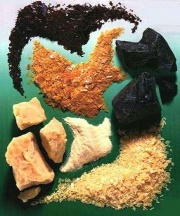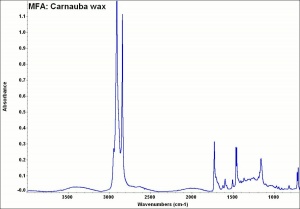Carnauba wax
Description
A hard, yellowish vegetable wax exuded from the leaves of the palm tree, Copernicia cerifera, native to the arid regions of northeastern Brazil. The leaves are collected, dried then beaten to remove the wax surface coating. The yellowish wax is purified and bleached prior to marketing. Carnauba wax is harder than beeswax and melts at a higher temperature. Carnauba wax contains ceryl palmitate, myricyl ceretate, myricyl alcohol (C30H61OH) along with other high molecular weight esters and alcohols. Olho wax is a pure whitish gray carnauba wax obtained from young leaves. Refined olho wax is called flora wax. Palha wax is a brownish wax obtained from older leaves. Palha wax can be emulsified with water to form chalky wax. Carnauba is used in floor waxes, such as Butcher's wax, on wooden floors and bowling alleys. It is also used in shoe polishes, leather finishes, carbon paper, lubricants, metal casting, printing inks, varnishes, and rubber coating.
Synonyms and Related Terms
Copernicia cerifera; Corypha cerifera; Brazil wax; ceara wax; olho wax; flora wax; pahla wax; chalky wax; Butcher's wax; Carnaubawachs (Deut.); carnauba wosk (Pol.)
Risks
Combustible.
Talas: MSDS
Physical and Chemical Properties
- Soluble in ether, boiling ethanol and alkalis. Insoluble in water.
- Saponification number = 78-95
- Acid number = 0.4-9.7
- Iodine number = 7.2-13.5
- Total % alcohols and hydrocarbons = 54-55
- Melting Point = 80-86 C
- Density = 0.990-0.999 g/ml
- Refractive Index = 1.467- 1.472
Comparisons
Resources and Citations
- R. J. Gettens, G.L. Stout, Painting Materials, A Short Encyclopaedia, Dover Publications, New York, 1966 Comment: Lists tree as Corypha cerifera
- Ralph Mayer, A Dictionary of Art Terms and Techniques, Harper and Row Publishers, New York, 1969 (also 1945 printing) Comment: melting range = 83-86C
- Matt Roberts, Don Etherington, Bookbinding and the Conservation of Books: a Dictionary of Descriptive Terminology, U.S. Government Printing Office, Washington DC, 1982 Comment: Lists tree as Copernicia cerifera; melting range = 83-84C
- Reed Kay, The Painter's Guide To Studio Methods and Materials, Prentice-Hall, Inc., Englewood Cliffs, NJ, 1983 Comment: Lists tree as Copernicia cerifera; melting point near 85C
- John S. Mills, Raymond White, The Organic Chemistry of Museum Objects, Butterworth Heineman, London, 2nd ed., 1994
- A History of Technology, Charles Singer, E.J. Holmyard, A.R. Hall (eds.), Clarendon Press, Oxford, Volume 1: From Early times to Fall of Ancient Empires, 1954
- Wikipedia: http://en.wikipedia.org/wiki/Carnauba_wax (Accessed Feb. 10, 2006) lists as from carnauba palm Copernicia cerifera
- CRC Handbook of Chemistry and Physics, Robert Weast (ed.), CRC Press, Boca Raton, Florida, v. 61, 1980 Comment: melting point=83-86C, density=0.990-1.001, ref. index=1.467-1.472, iodine value=7.2-13.5, acid value=2.9-9.7, saponification value=78-95
- G.S.Brady, Materials Handbook, McGraw-Hill Book Co., New York, 1971 Comment: p. 147-148; melting point=85C, density=0.995
- Kurt Wehlte, The Materials and Techniques of Painting, Van Nostrand Reinhold Co., New York, 1975
- Encyclopedia Britannica, http://www.britannica.com Comment: "Carnauba Wax." Accessed 14 Apr. 2004. Lists tree as Copernicia cerifera
- Richard S. Lewis, Hawley's Condensed Chemical Dictionary, Van Nostrand Reinhold, New York, 10th ed., 1993
- Random House, Webster's Encyclopedic Unabridged Dictionary of the English Language, Grammercy Book, New York, 1997
- The American Heritage Dictionary or Encarta, via Microsoft Bookshelf 98, Microsoft Corp., 1998
- Art and Architecture Thesaurus Online, http://www.getty.edu/research/tools/vocabulary/aat/, J. Paul Getty Trust, Los Angeles, 2000

